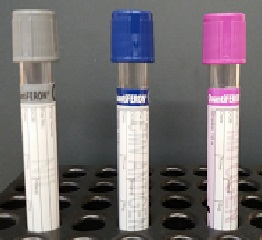Specimen Transport
Transport to laboratory at ambient temperatureSample Processing in Laboratory
Samples processed taken to immunology Laboratory and processed on same day.Sample Preparation
If a “butterfly needle” is being used to collect blood, a “purge” tube should be used to ensure that the tubing is filled with blood prior to the QF-CMV tubes being used.Turnaround Time
7-14 DaysSample Stability
Samples should be placed into a 37 C incubator as soon as possible after venepuncture , Must be no later than 16 hours post venepuncture.QuantiFERON-CMV (QF-CMV) In-tube interferon gamma release (IGRA) test for evaluating anti - CMV immunity.
General Information
QuantiFERON-CMV (QF-CMV) is an in vitro assay using a peptide cocktail simulating human cytomegalovirus (CMV) proteins to stimulate cells in heparinized whole blood. Detection of interferon gamma (IFN-) by Enzyme-linked immunosorbent Assay (ELISA) is used to quantify in vitro responses to these peptide antigens that are associated with immune control of CMV infection. Loss of this immune function may be associated with development of CMV disease. The intended use of QF-CMV is to monitor a patient’s level of anti-CMV immunity. QF-CMV is not a test for determining CMV infection and should not be used to exclude CMV infection. Immune monitoring of CMV-specific T cell responses may predict individuals at risk of CMV disease post transplant and may be useful in guiding prophylaxis and pre-emptive therapies. CMV is a herpes virus that infects between 50 – 85% of adults. Primary infection is followed by life long latency. It is particularly problematic in immunosuppressed patients post transplant, contributing to morbidity and mortality. Current immunosuppressive therapies used to prevent the rejection of a transplanted organ have a detrimental effect on T cells and cell mediated immunity (CMI), resulting in increased susceptibility to viral infections post-transplant. CD8+ cytotoxic T cell (CTL) can protect against virus-associated pathogenesis. Enumeration of CMV-specific CTL in immunosuppressed patients requires knowledge of patient HLA type and tetramer availability, and is prohibitively expensive for routine monitoring purposes. IFN- production is a functional surrogate for the identification of CMV-specific CTLs. Thus the production of IFN-may be predictive of the risk of developing CMV disease. Interferon gamma release assays (IGRAs) such as QF-CMV are simple to perform, cost effective, reproducible and have rapid turnaround times. It is currently the only standardized commercial immune monitoring assay capable of detecting CMV-induced IFN-. QF-CMV is an assay for CMI responses to CMV peptide antigens. The CMV peptides are designed to target CD8+ T cells, including A1, A2, A3, A11, A23, A24, A26, B7, B8, B27, B35, B40, B41, B44, B51, B52, B57, B58, B60 and Cw6 (A30, B13) HLA Class I haplotypes, covering >98% of the human population. Individuals infected with CMV usually have CD8+ T cells in their blood that recognize these antigens. This recognition process involves the generation and secretion of the cytokine IFN-. The detection and quantitation of IFN- forms the basis of this test.
Patient Preparation
No specific patient preparation required
Notes
Use of QF-CMV in solid organ transplantation. CMV serology is widely used pre-transplantation to establish risk of CMV complications post transplantation, but has limited value post-transplantation. QF-CMV may be used to assess CMV immunity post transplantation, in patients at risk of developing symptomatic CMV disease due to immunosuppression. • Transplant patients with QF-CMV Reactive result at completion of anti-CMV prophylaxis have a significantly lower rate of late onset disease compared with those having a QF-CMV Non-Reactive result. • Higher risk transplant patients (ie CMV+/CMV-) with a Reactive QF-CMV result any time post prophylaxis have a 90% chance of remaining free from CMV disease. • QF-CMV may prove useful in the prediction of spontaneous viral clearance compared to CMV disease progression following elevations in CMV viraemia. Higher incidence of post transplant CMV replication was seen in recipients with a QF-CMV Non-Reactive result compared to recipients with a Reactive result. • Pre-transplant QF-CMV Non-Reactive recipients who receive an organ from a CMV-seropositive donor have a 10-fold increase of CMV replication compared to a pre-transplant QF-CMT Reactive recipient. Use of QF-CMV in haematological transplantation. In haemopoietic stem cell transplantation (HSCT), reactivation of latent virus is more common than acquisition of primary infection. Preventing reactivation required a robust T cell mediated immune reponse. Immunosuppression and T cell depleting protocols used pre-HSCT affect the risk of reactivation. Delayed reconstitution of cellular immunity and cytopenias, as well as toxicity of anti-viral drugs (particularly ganciclovir) post-HSCT, is particularly problematic. HLA-mis matched transplants where immunosuppression is increased and GVHD more likely, are particularly likely to reactivate CMV, and have a survival disadvantage. Pre-transplant screening and pre-emptive therapy based on CMV viral load are employed routinely by transplant centres. Demonstration of a CMV-specific T cell response may help: • select patients who do not require continual treatment • assist therapeutic decisions regarding anti-viral drug use (reducing unnecessary drug toxicities and myelosuppressive side effects) and donor T cell infusions.
Reference Range
Results reported as interpretive comments: Anti CMV immunity NOT detected Anti-CMV immunity detected Result indeterminate for CMV responsiveness
Specifications
- EQA Scheme?: No
- EQA Status: Currently there is no EQA scheme available.Laboratory is currently participating in the NEQAS scheme for QFT-TB, which will indicate if there are generic quality issues with the IFN ELISA.
